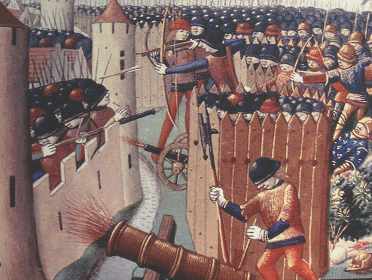Siege of Orleans

Why the Siege of Orleans is considered the Turning Point of the Hundred Years’ War
The Siege of Orleans, also known as the Battle of Orleans is considered the turning point of the Hundred Years’ War that was fought between France and England from 1337 to 1453. The French led by Joan of Arc who claimed to have had divine guidance managed to defend the last stronghold loyal to dauphin Charles (later Charles VII of France) and prevent the fall of France which seemed close. The English achieved several important victories in the 1420’s and they would only need to capture Orleans, a city on the north bank of the Loire River in north-central France.
English Failure to Encircle the City
The English led by Thomas de Montacute, 4th Earl of Salisbury laid siege to Orleans on October 12, 1428, but they did not make any attempts to capture the city. Orleans was surrounded by 30 feet (9 meters) high walls, while Salisbury’s troops were outnumbered by the city defenders. Salisbury died on November 3 after being hit by a cannon ball and was replaced by William de la Pole, Duke of Suffolk. The latter withdrew the troops and left only a small force at the city but he was forced to return to Orleans after the arrival of John Talbot in December 1428. The English set up a network of fortified positions around Orleans by spring 1429 but they failed to encircle the city and cut off its supply lines.
French Attempts to Relieve the Siege
The French were not any more successful in relieving the siege and the only significant military action near the town of Rouvray (Battle of the Herrings) in February 1429 failed to achieve its objectives – to intercept and divert the English supply convoy. In fact, the French defenders commanded by Count of Dunois (also known as Bastard of Orleans) were considering surrender when Joan of Arc, a 17-year old peasant girl persuaded dauphin Charles to sent an army to Orleans.
Arrival of Joan of Arc to Orleans and her First Military Success
Joan arrived to the city on April 30, 1429, but not as commander as the army sent to Orleans was commanded by Duke of Alencon. The rest of the army got into the city through a gap in the English lines by May 4. After her arrival to Orleans, Joan sent a letter to the English commander demanding the lift of the siege. In response to the English rejection of her demands, she rode out of the city with a diversionary force and attacked the English at the fort of Saint Loup on May 4. The action was a success and once again, she demanded from the English to abandon the siege.
Raising the Siege of Orleans
Another English refusal was followed by the second Joan’s action. She rode out again two days later and attacked the English positions on the south bank in front of the fortified gatehouse of Les Tourelles where she was hit by an arrow. The wound, however, was only superficial and the English who were convinced that “the witch“ (as they called her) was dead could not believe their eyes when seeing her back on the battlefield. The English positions were soon overrun and the last troops retreated to Les Tourelles which fell to the French on May 7. One day later, on May 8, the English abandoned the siege and the French took the victory.




